-
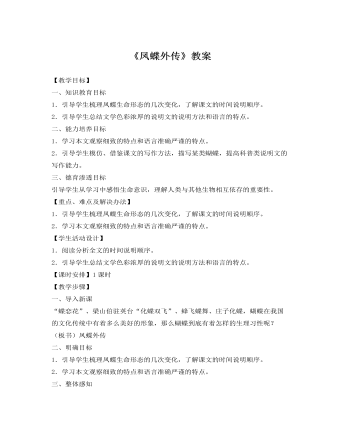
人教版高中语文《凤蝶外传》教案
【教学目标】一、知识教育目标1.引导学生梳理凤蝶生命形态的几次变化,了解课文的时间说明顺序。2.引导学生总结文学色彩浓厚的说明文的说明方法和语言的特点。二、能力培养目标1.学习本文观察细致的特点和语言准确严谨的特点。2.引导学生模仿、借鉴课文的写作方法,描写某类蝴蝶,提高科普类说明文的写作能力。三、德育渗透目标引导学生从学习中感悟生命意识,理解人类与其他生物相互依存的重要性。【重点、难点及解决办法】1.引导学生梳理凤蝶生命形态的几次变化,了解课文的时间说明顺序。2.学习本文观察细致的特点和语言准确严谨的特点。【学生活动设计】1.阅读分析全文的时间说明顺序。2.引导学生总结文学色彩浓厚的说明文的说明方法和语言的特点。
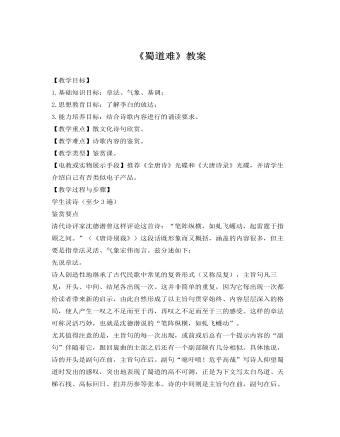
人教版高中语文《蜀道难》教案
一、对经典艺术作品的解释往往是仁者见仁,智者见智,这是正常现象。对于有争论的问题,我们应当本着有利于学生鉴赏的原则要善地加以解决。例如:①这首诗的写作年代,根据王定保的材料可以确定为不会晚于天宝三载(744)诗人离开长安以前。这自然是一个笼统的说法,因此我们再据诗的内容说它作于诗人身居长安之时,这样讲起来就比较方便。当然,也有可能比这更早,但目前尚无资料可以证明,不宜作这样的假设。这个问题在“有关资料”中有进一步的说明,但只提供教师参考,不要讲给学生听。②诗中的“君”可能是诗人的一位朋友,也可能是一种虚拟方式,即实无其人而是泛指所有“西游”之人,二说并通。为便于学生接受,可以采用前一种说法;如采用后一种说法,则应作一番解释,说说这样写的好处。③诗的寓意只宜采取胡震亭的说法,言“险”即所以申“戒”,“险”“戒”二字高度概括了诗中要旨,这样来理解,对鉴赏也十分有利。

人教版高中语文《荷塘月色》教案
一、自读感知要求学生自读课文,整体感知整篇课文,了解作品的基本内容,初步把握作品的基本结构框架和作者的感情。首先自读课文,疏通文句,借助注解和词典,弄清以下词语的读音和意思:幽僻、蓊蓊郁郁、弥望、袅娜、宛然、凝碧、斑驳、峭楞楞借助注解和词典读懂《采莲赋》。其次给文章八个小段标上序号,找出文章主要写景的段落和抒情的段落,找出文章抒情的语句。明确:文章主要写景的段落是第四段、第五段、第六段。文章主要抒情的段落是第三段。文章抒情的语句主要有:第一段:这几天心里颇不宁静。第二段:没有月光的晚上,这路上阴森森的,有些怕人。今晚却很好,虽然月光也还是淡淡的。第三段:我也像超出了平常的自己,我爱热闹,……也爱冷静;爱群居,也爱独处。……便觉是一个自由的人。……我且受用这无边的荷香月色好了。第六段:但热闹是他们的,我什么也没有。第七段:这真是有趣的事,可惜我们现在早已无福消受了。
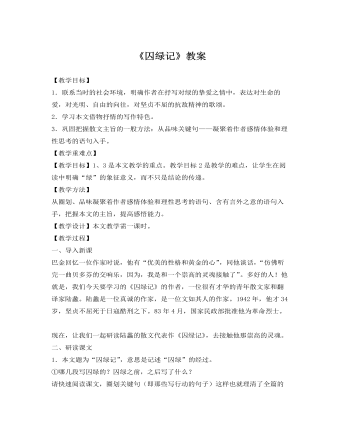
人教版高中语文《囚绿记》教案
6.小结:作者以一株常春藤为线索,牵出无限的情思,唱出了一曲绿色生命之歌。绿色是自然给予人类的审美心理需求,它给人以和平安宁的象征,给人以生命活力的感召力量。古诗词中就有不少写“绿”的名句,能背几句吗?(学生背诵,谈自己的理解。)这些诗句中写到绿,体现了诗人独特的感悟、思想,因此千古传颂。绿在视觉上给人以美感,色彩美;心理上使人愉悦,安宁。这就是一般人都喜欢绿,爱绿的原因。而我们的作者在“烽火四逼”的民族危亡时刻,不仅写爱绿,更赋予绿以时代需要的象征意义——(齐读板书。)我们从中窥见他渴望光明、自由,呼唤永不屈服于黑暗的“崇高的灵魂”。他确实有一颗——“黄金的心”。在那抗日救国的年代,《囚绿记》确有照亮民族心灵的作用。
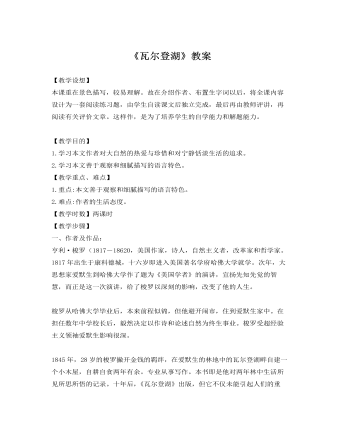
人教版高中语文《瓦尔登湖》教案
【教学步骤】一、作者及作品:亨利·梭罗(1817-18620,美国作家,诗人,自然主义者,改革家和哲学家。1817年出生于康科德城,十六岁即进入美国著名学府哈佛大学就学。次年,大思想家爱默生到哈佛大学作了题为《美国学者》的演讲,宣扬先知先觉的智慧,而正是这一次演讲,给了梭罗以深刻的影响,改变了他的人生。梭罗从哈佛大学毕业后,本来前程似锦,但他避开闹市,住到爱默生家中。在担任数年中学校长后,毅然决定以作诗和论述自然为终生事业。梭罗受超经验主义领袖爱默生影响很深。1845年,28岁的梭罗撇开金钱的羁绊,在爱默生的林地中的瓦尔登湖畔自建一个小木屋,自耕自食两年有余。专业从事写作。本书即是他对两年林中生活所见所思所悟的记录。十年后,《瓦尔登湖》出版,但它不仅未能引起人们的重视,相反还遭到批评和讥讽。然而,随着时光的流逝,这本书的影响却越来越大,终而成为美国文学中的一本独特的、卓越的名著。

新人教版高中英语选修2Unit 5 Learning about Language教学设计
The purpose of this section of vocabulary exercises is to consolidate the key words in the first part of the reading text, let the students write the words according to the English definition, and focus on the detection of the meaning and spelling of the new words. The teaching design includes use English definition to explain words, which is conducive to improving students' interest in vocabulary learning, cultivating their sense of English language and thinking in English, and making students willing to use this method to better grasp the meaning of words, expand their vocabulary, and improve their ability of vocabulary application. Besides, the design offers more context including sentences and short passage for students to practice words flexibly.1. Guide students to understand and consolidate the meaning and usage of the vocabulary in the context, 2. Guide the students to use the unit topic vocabulary in a richer context3. Let the students sort out and accumulate the accumulated vocabulary, establishes the semantic connection between the vocabulary,4. Enable students to understand and master the vocabulary more effectivelyGuiding the Ss to use unit topic words and the sentence patterns in a richer context.Step1: Read the passage about chemical burns and fill in the blanks with the correct forms of the words in the box.
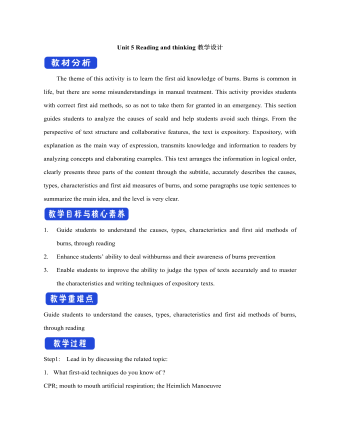
新人教版高中英语选修2Unit 5 Reading and thinking教学设计
The theme of this activity is to learn the first aid knowledge of burns. Burns is common in life, but there are some misunderstandings in manual treatment. This activity provides students with correct first aid methods, so as not to take them for granted in an emergency. This section guides students to analyze the causes of scald and help students avoid such things. From the perspective of text structure and collaborative features, the text is expository. Expository, with explanation as the main way of expression, transmits knowledge and information to readers by analyzing concepts and elaborating examples. This text arranges the information in logical order, clearly presents three parts of the content through the subtitle, accurately describes the causes, types, characteristics and first aid measures of burns, and some paragraphs use topic sentences to summarize the main idea, and the level is very clear.1. Guide students to understand the causes, types, characteristics and first aid methods of burns, through reading2. Enhance students’ ability to deal withburnss and their awareness of burns prevention3. Enable students to improve the ability to judge the types of texts accurately and to master the characteristics and writing techniques of expository texts.Guide students to understand the causes, types, characteristics and first aid methods of burns, through readingStep1: Lead in by discussing the related topic:1. What first-aid techniques do you know of ?CPR; mouth to mouth artificial respiration; the Heimlich Manoeuvre

新人教版高中英语选修2Unit 5 Using langauge-Listening教学设计
The theme of this section is to learn how to make emergency calls. Students should learn how to make emergency calls not only in China, but also in foreign countries in English, so that they can be prepared for future situations outside the home.The emergency telephone number is a vital hotline, which should be the most clear, rapid and effective communication with the acute operator.This section helps students to understand the emergency calls in some countries and the precautions for making emergency calls. Through the study of this section, students can accumulate common expressions and sentence patterns in this context. 1.Help students accumulate emergency telephone numbers in different countries and learn more about first aid2.Guide the students to understand the contents and instructions of the telephone, grasp the characteristics of the emergency telephone and the requirements of the emergency telephone.3.Guide students to understand the first aid instructions of the operators.4.Enable Ss to make simulated emergency calls with their partners in the language they have learned1. Instruct students to grasp the key information and important details of the dialogue.2. Instruct students to conduct a similar talk on the relevant topic.Step1:Look and discuss:Match the pictures below to the medical emergencies, and then discuss the questions in groups.
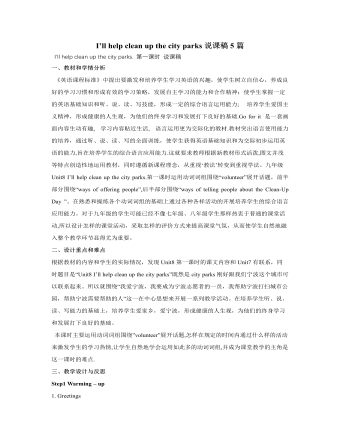
人教版新目标初中英语九年级下册I’ll help clean up the city parks说课稿5篇
二、教法学法1、任务型教学法:每个教学环节都是围绕着如何完成一个教学任务来设计的。2、感悟法:创设语境,让学生在一定的语言环境中感悟语言内涵,从而实现悟中学的目的。只有学生自己悟出的东西才能较好地内化为自己的东西。3、合作点拨法:通过教师创设的学习氛围,设置问题和反思质疑,推动师生,生生间的合作探究,小组合作学习,在解决问题中完成教学目标。以培养他们的合作探究的意识与精神。三、教学程序1 导入新课利用课件中的图片导入:在大屏幕上出示汶川大地震中一些悲惨的图片,让同学们说出汶川,然后老师说as well-know a stong earthquake happened in wenchuan,so many kind people go there to help others.再出示一些军人,医疗工作者,志愿者忙碌的身影,特别是温家宝总理看望受伤的孩子,让同学们知道一方有难,四方支持,帮助困难中的人是很有意义的。然后说Would you like to help others?What would you like to do?
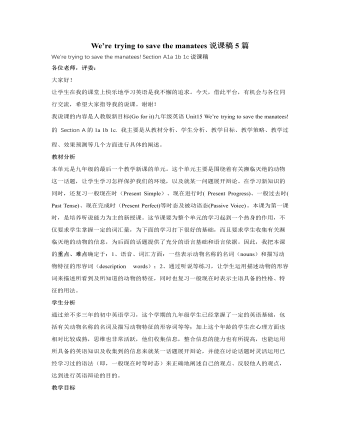
人教版新目标初中英语九年级下册We’re trying to save the manatees说课稿5篇
教材分析本单元是九年级的最后一个教学新课的单元。这个单元主要是围绕着有关濒临灭绝的动物这一话题,让学生学习怎样保护我们的环境,以及就某一问题展开辩论。在学习新知识的同时,还复习一般现在时(Present Simple)、现在进行时( Present Progress)、一般过去时( Past Tense)、现在完成时(Present Perfect)等时态及被动语态(Passive Voice)。本课为第一课时,是培养听说能力为主的新授课。这节课要为整个单元的学习起到一个热身的作用,不仅要求学生掌握一定的词汇量,为下面的学习打下很好的基础,而且要求学生收集有关濒临灭绝的动物的信息,为后面的话题提供了充分的语言基础和语言依据。因此,我把本课的重点、难点确定于:1、语音、词汇方面:一些表示动物名称的名词(nouns)和描写动物特征的形容词(description words);2、通过听说等练习,让学生运用描述动物的形容词来描述所看到及所知道的动物的特征,同时也复习一般现在时表示主语具备的性格、特征的用法。
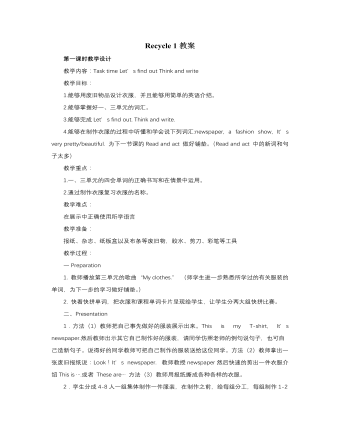
人教版新课标PEP小学英语四年级下册Recycle 1教案
1.Think and write接上一个环节,老师说“Zoom is careless. Where are his things? Let’s look.” 让学生看课本图片,认真观察。a. 教师给出例句,请同学仿照例句说出句子Zoom’s red shoes are in the library.Zoom’s green sweater is in the gym.b.学生完成课本图片后的短文。可以找程度好的同学在黑板上书写。c.让学生在小组内朗读句子。2. Let’s read..出示钟表模型,老师拨出几个有代表性的时间,学生分两组用“What time is it ? It’s ........It’s time to ……”进行问答。老师在学生回答时把时间和活动写在黑板上如下:Time Activities7:00 get up 7:30 go to school9:00have Chinese/math class10:00read books 或其他12:00 eat lunch3:15have P.E classOh, you have a busy day. Look, this is John’s day.a. 由上个环节引出John’s list. 教师引导学生仔细看Let’s read 部分的图,阅读John的活动时间表, 然后独立完成句子的正误判断,最后进行检查。b.让学生再次读John的活动时间表,回答下面的问题:What time does John go to school? Where does John read books?
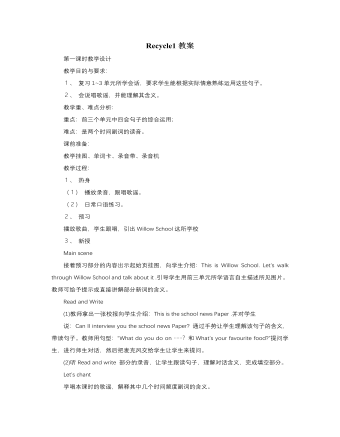
人教版新课标PEP小学英语五年级上册Recycle1教案
巩固延伸尝试与他人进行书信交流第三课时教学设计教学目的与要求:1、 能够使用所学四会句子完成Task time中的采访任务。2、 能够理解Let’s play中的问题并做出正确回答。3、 能够听懂、会唱歌曲“My Favourite Day”。教学重、难点:重点、难点为复习并使用四会句子完成Task time中的采访任务,并展示个人报道。课前准备:教学挂图、录音带、录音机、简历表教学过程:1、 热身(1) 放第二单元歌曲,学生跟唱,复习有关一周七天的单词。(2) 日常口语练习。2、 预习:放录音,欣赏歌曲。3、 新授Task time(1) 就歌曲内容向学生提问:Do you like weekends? What’s your favourite day? 引导学生回答:My favourite day is Saturday/Sunday. 并请学生说明理由,表述周末活动。出示采访表,回答问题。(2) 让学生参照学生用书的采访表进行小组交流,并在最短的时间内填充表格,然后每组派代表做汇报。Let’s play看图片,指导学生先读懂句子,再回答问题。Let’s sing学生理解并学唱本单元歌曲“My Favourite Day”.巩固延伸:采访教师;画画猜人
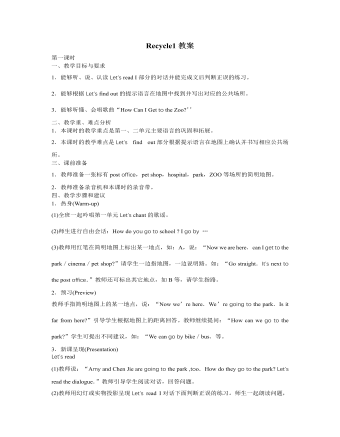
人教版新课标PEP小学英语六年级上册Recycle1教案
1.热身(warm-up) (1)全班齐唱歌曲“How call I Get to the Zoo?’’ (2)师生一起吟唱第一单元的歌谣,要求学生一边吟唱,一边用手打节拍。 2.预习(Preview) 教师对学生有关My Dream Vacation的短文做出总体评价,并请几名写得有创意的学生朗读他们的短文,教师针对其内容提问,如:“Where are you going? What are you going to do? How are you going to there等。教师根据课前的准备,在最后一名学生朗读完文章并回答了问题以后,简化并板书该学生的回答,将其改编成为一首小歌谣,如: Where are you going? What are you going to do? I’m going to the ZOO to see the monkeys. I’m going by bike.I’m going On foot. I live near the ZOO.So I won’t take a train. 教师拍节拍示范朗读自己改写的新歌谣,学生模仿吟唱新歌谣。 3.新课呈现(Presentation) Let’s chant 在以上活动的基础上,教师放Let’s chant部分的录音,学生静听并试着跟读,再看着文字吟唱。师生可进行问答式吟唱,并在小组间展开比赛。 Listen and match

人教版高中地理选修5中国的自然灾害教案
(3)2004年6月末至7月初,广东省出现罕见的大面积持续高温炎热天气,全省有45个县(市)的最高气温破历史同期记录。造成此次异常天气的主要原因是()A.副热带高压和热带气旋外围下沉气流共同影响B.大量使用汽车和制冷设备C.绿色植物呼吸作用释放CO:D.全球温室效应长期作用【解析】(1)根据“源于西太平洋洋面的台风”判断该台风属于北半球的气旋型的天气系统,当台风中心位于南海时,广东沿海地区正好位于该气旋的北部,故吹东北风。(2)夏秋季节的台风主要影响我国的南部、东部沿海地区,广东沿海正好位于该地区,受到的影响较大;广东沿海是我国经济非常发达的地区,富含有N、P、K等营养元素的工厂生产、农业生产、生活废水的排放导致海水中的藻类物质大量繁殖,水中的溶解氧减少,鱼类因窒息而死亡的现象在该地区时常发生。(3)从题干中提供的信息分析可知,6月末至7月初为北半球的夏季,因是短期的高温,与正常年份相比出现异常天气是因副热带高压和热带气旋外围下沉气流共同影响。
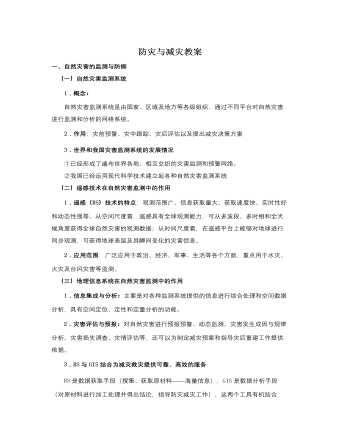
人教版高中地理选修5防灾与减灾教案
(一)自然灾害监测系统1.概念:自然灾害监测系统是由国家、区域及地方等各级组织,通过不同平台对自然灾害进行监测和分析的网络系统。2.作用:灾前预警、灾中跟踪、灾后评估以及提出减灾决策方案3.世界和我国灾害监测系统的发展情况①已经形成了遍布世界各地、相互交织的灾害监测和预警网络。②我国已经运用现代科学技术建立起各种自然灾害监测系统(二)遥感技术在自然灾害监测中的作用1.遥感(RS)技术的特点:观测范围广、信息获取量大、获取速度快、实时性好和动态性强等。从空间尺度看,遥感具有全球观测能力,可从多波段、多时相和全天候角度获得全球自然灾害的观测数据;从时间尺度看,在遥感平台上能够对地球进行同步观测,可获得地球表层及其瞬间变化的灾害信息。
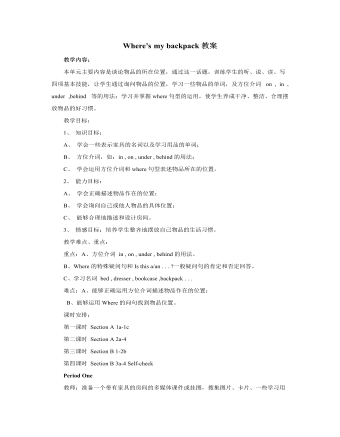
人教版新目标初中英语七年级上册Where’s my backpack教案
教师: 搜集单词卡片、背景资料。 学生:彩笔、大白纸、相关新单词。 教学设计 Step One: Learn the new words. 1.Present the new words. (Show some pictures and words on the screen to teach the students the new words.) T: What’s this? S1: It’s a room. T: Do you have a room like this? S2: Yes, I do./ No, I don’t. T: Read after me. R-O-O-M, room. Ss: R-O-O-M, room. (Teach the other words “TV, desk, picture” in the same way.) T: There are some words here. Read the words after me and spell them. (Learn the other words without pictures on the cards.) T: This is a word. Can you spell this word? (Point to a word in the card.) S1: Yes, I can. / No, I can’t. (Let them know the meaning of “can”.) T: I can spell your name. Can you spell my name? S1: Yes, I can. T: Can you write your name? S: Sorry, I can’t. I have no pen. T: You need a pen.( Give him a pen.) ( Let the students understand the word “need”.) T: I bring a football to school every day. Now it is on the floor. After class I take it to my home. (Teach “bring” and “take”. Put a football on the floor and point to the floor to teach the word “floor”.) 2.Practice the words. (Give the examples to the students and get the students to understand the new words.) Step To Listen and practice.
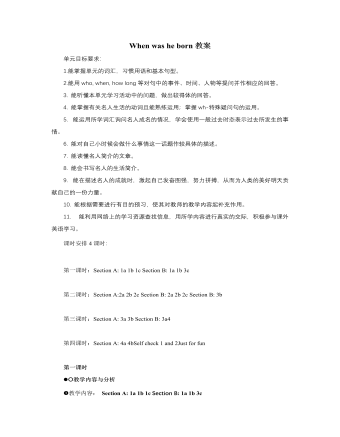
人教版新目标初中英语八年级上册When was he born教案
1.能掌握单元的词汇,习惯用语和基本句型。2.能用who, when, how long等对句中的事件、时间、人物等提问并作相应的回答。3. 能听懂本单元学习活动中的问题,做出较得体的回答。4. 能掌握有关名人生活的动词且能熟练运用;掌握wh-特殊疑问句的运用。5. 能运用所学词汇询问名人成名的情况,学会使用一般过去时态表示过去所发生的事情。 6. 能对自己小时候会做什么事情这一话题作较具体的描述。7. 能读懂名人简介的文章。8. 能会书写名人的生活简介。9. 能在描述名人的成就时,激起自己发奋图强,努力拼搏,从而为人类的美好明天贡献自己的一份力量。10. 能根据需要进行有目的预习,使其对教师的教学内容起补充作用。11. 能利用网络上的学习资源查找信息,用所学内容进行真实的交际,积极参与课外英语学习。课时安排4课时:第一课时:Section A: 1a 1b 1c Section B: 1a 1b 3c第二课时:Section A:2a 2b 2c Section B: 2a 2b 2c Section B: 3b
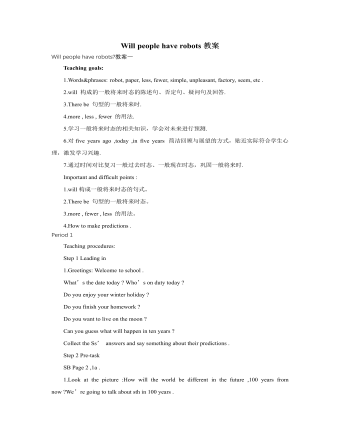
人教版新目标初中英语八年级下册Will people have robots教案
Teaching goals:1.Words&phrases: robot, paper, less, fewer, simple, unpleasant, factory, seem, etc .2.will 构成的一般将来时态的陈述句、否定句、疑问句及回答.3.There be 句型的一般将来时.4.more , less , fewer 的用法.5.学习一般将来时态的相关知识,学会对未来进行预测.6.对five years ago ,today ,in five years 简洁回顾与展望的方式,贴近实际符合学生心理,激发学习兴趣.7.通过时间对比复习一般过去时态、一般现在时态,巩固一般将来时.Important and difficult points :1.will构成一般将来时态的句式。2.There be 句型的一般将来时态。3.more , fewer , less 的用法。4.How to make predictions .Period 1Teaching procedures:Step 1 Leading in1.Greetings: Welcome to school .What’s the date today ? Who’s on duty today ?Do you enjoy your winter holiday ?Do you finish your homework ?Do you want to live on the moon ?Can you guess what will happen in ten years ?Collect the Ss’ answers and say something about their predictions .Step 2 Pre-taskSB Page 2 ,1a .1.Look at the picture :How will the world be different in the future ,100 years from now ?We’re going to talk about sth in 100 years .
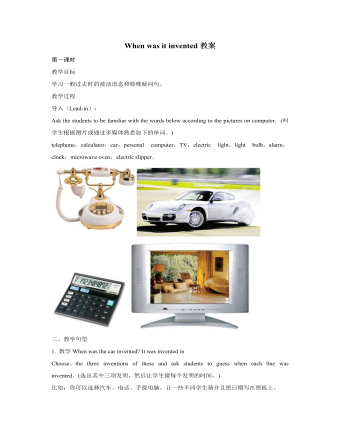
人教版新目标初中英语九年级下册When was it invented教案
二、教学 1a,1b.1.First the teacher asks the students what kind of fruit food and drink you like the best and writes down on the blackboard.教师问学生最喜欢什么水果和饮料并把它们写在黑板上。比如:potato chips,ice cream,tea,lemon,chocolate,oranges,salad,popcorn,pickle and so on.2.接着叫学生表达以上食物的味道,引出新单词——sweet,crispy,salty,sour,delicious,hot,awful,nice…并且完成lb教学内容通过此活动,以旧带新引入新单词。其目的是让学生自主学习新知识。 三、教学 2a,2b1.首先,听力前的brainstormFirst,Let students describe how potato chips taste and describe how helpful the potato chips.Then,ask:When and where were potato chips invented?Who were potato chips invented by?How were potato chips invented?(Let students guess according to the following key words.)Key words:by accident,customer,restaurant,by mistake.(说明:通过问题让学生对对话内容有整体了解,为听力练习做好准备;又培养学生的注意力,想像力,观察力。)
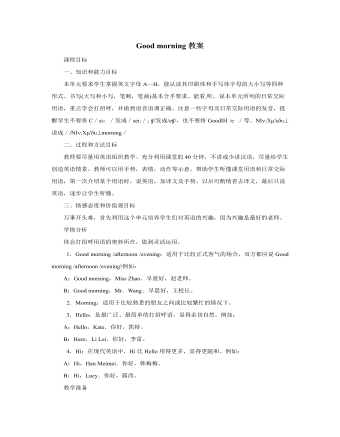
人教版新目标初中英语七年级上册Good morning教案
一、知识和能力目标本单元要求学生掌握英文字母A—H,能认读其印刷体和手写体字母的大小写等四种形式。书写(大写和小写,笔顺,笔画)基本合乎要求。能看,听,说本单元所列的日常交际用语,重点学会打招呼,并做到语音语调正确。注意一些字母及日常交际用语的发音,提醒学生不要将C/si:/发成/sei:/; ?/发成/e?/,也不要将Good?H /e /等。??????'????说成/???????'???morning/二、过程和方法目标教师要尽量用英语组织教学。充分利用课堂的40分钟,不讲或少讲汉语,尽量给学生创造英语情景。教师可以用手势,表情,动作等示意,帮助学生听懂课堂用语和日常交际用语,第一次介绍某个用语时,说英语,加译文及手势,以后可酌情省去译文,最后只说英语,逐步让学生听懂。

